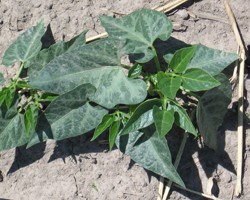2015 Lima Bean Herbicide Chart
Julie Kikkert, Team Leader, Extension Vegetable Specialist
Cornell Vegetable Program

Serious injury can be caused to lima beans if Eptam, Reflex, Assure II/Targa, or PostEmergence applications of Pursuit are used.
Herbicides that are labeled for lima beans in New York are given in the table below. Mark VanGessel from the University of Delaware provides the following information: on our loamy soils (approx. 1% organic matter) growers use 1.0 to 1.25 pints/A of Dual Magnum (rates similar for snap beans) and 1.5 to 2.0 oz of Pursuit at planting. They can be used pre-plant incorporated (PPI), but most farmers are applying them immediately after planting (PRE). Sandea is also labeled, but Pursuit is a better fit for the weeds in DE. Basagran, Sandea, Poast and Select Max are labeled for post-emergence control, with the choice depending on the weeds that emerge. We have a lot of Pursuit/Sandea resistant pigweeds in DE so be sure to rotate away from this mode of herbicide action in years that you are not growing lima beans in these fields.
Herbicides for Lima Bean Weed Control in NY in 2015 (pdf; 112KB)

Upcoming Events
Vegetable Pest and Cultural Management Field Meeting for Auction Growers -- Ontario Produce Auction
July 15, 2025
Stanley, NY
This evening meeting will demonstrate pest management in fresh market vegetables in both field and greenhouse (high tunnel) vegetables, primarily for those growing for wholesale auction. A hands-on demonstration of weed, insect and disease identification in vegetables including management options. Details on each topic will focus on field observations at the farm.
Orleans Summer Vegetable Meeting, 2025
July 16, 2025
Waterport, NY
Meeting themes are pest management in a wide array of produce and best practices for pesticide use. Professor Brian Nault will cover allium leaf miner and thrips in onions, garlic, and leeks, and discuss insect challenges in other crops. Bring your questions! We'll also have a field walk that includes high tunnel tomato and cucumber.
DEC credits available: 0.5 in CORE plus either 1.25 in 1a and 23, or 0.75 in 24.
Vegetable Pest and Cultural Management Field Meeting for Auction Growers -- Finger Lakes Produce Auction
July 18, 2025
Penn Yan, NY
This evening meeting will demonstrate pest management in fresh market vegetables in both field and greenhouse (high tunnel) vegetables, primarily for those growing for wholesale auction. A hands-on demonstration of weed, insect and disease identification in vegetables including management options. Details on each topic will focus on field observations at the farm.


































